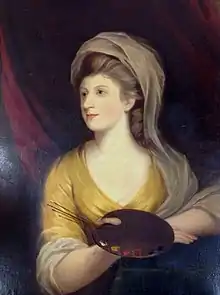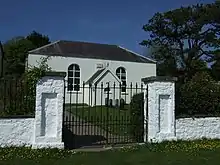Diana Noel, 2nd Baroness Barham
Diana Noel, 2nd Baroness Barham (18 September 1762 – 12 April 1823) was a peer, philanthropist and an abolitionist who established schools and churches on the Gower Peninsula.
Diana Noel | |
|---|---|
 | |
| Baroness Barham | |
| Reign | 17 June 1813-12 April 1823 |
| Predecessor | Charles Middleton, 1st Baron Barham |
| Successor | Charles Noel, 1st Earl of Gainsborough |
| Born | Diana Middleton 18 September 1762 Barham Court, Teston, Kent |
| Died | 12 April 1823 Fairy Hill, Gower |
| Buried | Teston |
| Spouse(s) | Sir Gerard Noel, 2nd Baronet |
| Issue | Charles Noel, 1st Earl of Gainsborough |
| Father | Charles Middleton |
| Mother | Margaret Gambier |
Early life
Born on 18 September 1762 at Barham Court, Teston in Kent, her parents were Margaret (née Gambier) and Charles Middleton,[1] an admiral who was created Baron Barham, of Barham Court and Teston in the County of Kent in May 1805.[2][3] They were Calvinist Methodists, whose friends included religious writer and philanthropist Hannah More, cleric George Whitefield, and politician and abolitionist William Wilberforce.[4]
Marriage
She was married on 21 December 1780 to Gerard Edwardes, who was a Cambridge-educated banker and member of Parliament.[1][5] In 1798, he inherited the estates of his uncle, Henry Noel, 6th Earl of Gainsborough, and changed his surname to Noel.[5] They had eighteen children,[1] one of whom, Baptist Wriothesley Noel, stated that his parents' home "combined whig politics, evangelical devotion, aristocratic unconventionality, and strong-mindedness in a potent blend".[6]
Gerard's estates, worth £20,800 a year and consisting of 15,000 acres, were put into trust due to the poor state of financial management by 1816.[6]
Baroness Barham

When her father died in 1813, as the only child, she became 2nd Baroness Barham by a special remainder.[2] That year, having found her husband to be a "profligate and eccentric husband", she moved to Fairy Hill, Gower, and began funding the construction of free schools as well as four Independent and two Calvinist Methodist churches.[1][6] She was also an abolitionist and was friends with Samuel Johnson.[2]
She died at Fairy Hill on 12 April 1823 and was buried at Teston.[1] Her son Charles became Lord Barham. He had the chapels transferred to trustees.[1] Her correspondence is archived with that of the Noel family at the Record Office of Leicestershire, Leicester and Rutland[7] and photographs related to her life are held at the Chipping Campden History Society.[8]
References
- Carter, Grayson (23 September 2004). "Noel [formerly Edwardes; née Middleton], Diana, suo jure Baroness Barham". Oxford Dictionary of National Biography (online ed.). Oxford University Press. doi:10.1093/ref:odnb/47112. Retrieved 4 November 2018. (Subscription or UK public library membership required.)
- "Charles Middleton 1st Lord Barham". More than Nelson. Retrieved 22 July 2017.
- John Bernard Burke (1845). A Genealogical and Heraldic Dictionary of the Peerage and Baronetage of the British Empire. H. Colburn. p. 421.
- Iorworth Hughes Jones (1956). "Lady Barham in Gower". Gower. 9: 2–3. hdl:10107/1273335.
- "Edwards (post Noel), Gerald Noel (EDWS776GN)". A Cambridge Alumni Database. University of Cambridge.
- "Sir Gerard Noel Noel 2nd Bart". Legacies of British Slave-ownership database. Retrieved 8 August 2017.
- "Middleton, Diana (1762-1823) Baroness Barham, wife of Sir Gerard Noel, 2nd Baronet". The National Archives. Retrieved 8 August 2017.
- "Lady Barham, Fairy Hill, Gower. Photographs and article". Chipping Campden History Society archive. Retrieved 4 November 2018.